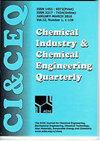Enhancing MRR and accuracy with magnetized graphite tool in electrochemical micromachining of copper
IF 0.8
4区 工程技术
Q4 CHEMISTRY, APPLIED
Chemical Industry & Chemical Engineering Quarterly
Pub Date : 2022-01-01
DOI:10.2298/ciceq220731027p
引用次数: 0
Abstract
Micro hole is the fundamental feature found in any device/components. Hence this paper aims to produces the micro holes using electrochemical micromachining (EMM). The existing machining techniques in EMM for creating micro holes are associated with more overcut (OC). Hence, it is very essential to reduce OC and enhance the machining rate (MR). This paper aspires to investigate the effect of graphite electrode with magnetic force on copper plate. Four different tools namely electromagnetic graphite tool (EMGT), permanent magnet graphite tool (PMGT), graphite tool and stainless steel (SS) tool are employed for these experiments. The major influencing factors are machining voltage in volts, duty cycle in % and electrolyte concentration in g/l was considered on MR and OC. The results exposed that EMGT, PMGT and graphite electrodes produce MR of 106.4%, 74.6 % and 44.5 % over SS tool at parameter level of 23 g/l, 15 V, and 85% respectively. Graphite and EMGT electrode resulting in 11.9% and 3.41 % reduced OC respectively than SS tool at parameter level of 8V, 95% and 28 g/l. Additionally, scanning electron microscope (SEM) picture examination is conducted to identify the magnetic field effect on the work surface.利用磁化石墨刀具提高铜微细电化学加工的MRR和精度
微孔是任何器件/组件的基本特征。因此,本文旨在利用电化学微加工(EMM)制造微孔。现有的EMM微孔加工技术存在较大的过切现象。因此,降低加工温度,提高加工速率是十分必要的。本文研究了石墨电极对铜板的磁力作用。实验采用了电磁石墨刀具(EMGT)、永磁石墨刀具(PMGT)、石墨刀具和不锈钢刀具(SS)四种不同的刀具。MR和OC分别考虑了加工电压(伏特)、占空比(%)和电解液浓度(g/l)的影响。结果表明,在23 g/l、15 V和85%的参数水平下,EMGT、PMGT和石墨电极的MR分别比SS工具高106.4%、74.6%和44.5%。在8V、95%和28 g/l的参数水平下,石墨电极和EMGT电极的OC分别比SS工具降低11.9%和3.41%。此外,通过扫描电镜(SEM)图像检测,确定磁场对工作表面的影响。
本文章由计算机程序翻译,如有差异,请以英文原文为准。
求助全文
约1分钟内获得全文
求助全文
来源期刊

Chemical Industry & Chemical Engineering Quarterly
CHEMISTRY, APPLIED-ENGINEERING, CHEMICAL
CiteScore
2.10
自引率
0.00%
发文量
24
审稿时长
3.3 months
期刊介绍:
The Journal invites contributions to the following two main areas:
• Applied Chemistry dealing with the application of basic chemical sciences to industry
• Chemical Engineering dealing with the chemical and biochemical conversion of raw materials into different products as well as the design and operation of plants and equipment.
The Journal welcomes contributions focused on:
Chemical and Biochemical Engineering [...]
Process Systems Engineering[...]
Environmental Chemical and Process Engineering[...]
Materials Synthesis and Processing[...]
Food and Bioproducts Processing[...]
Process Technology[...]
 求助内容:
求助内容: 应助结果提醒方式:
应助结果提醒方式:


